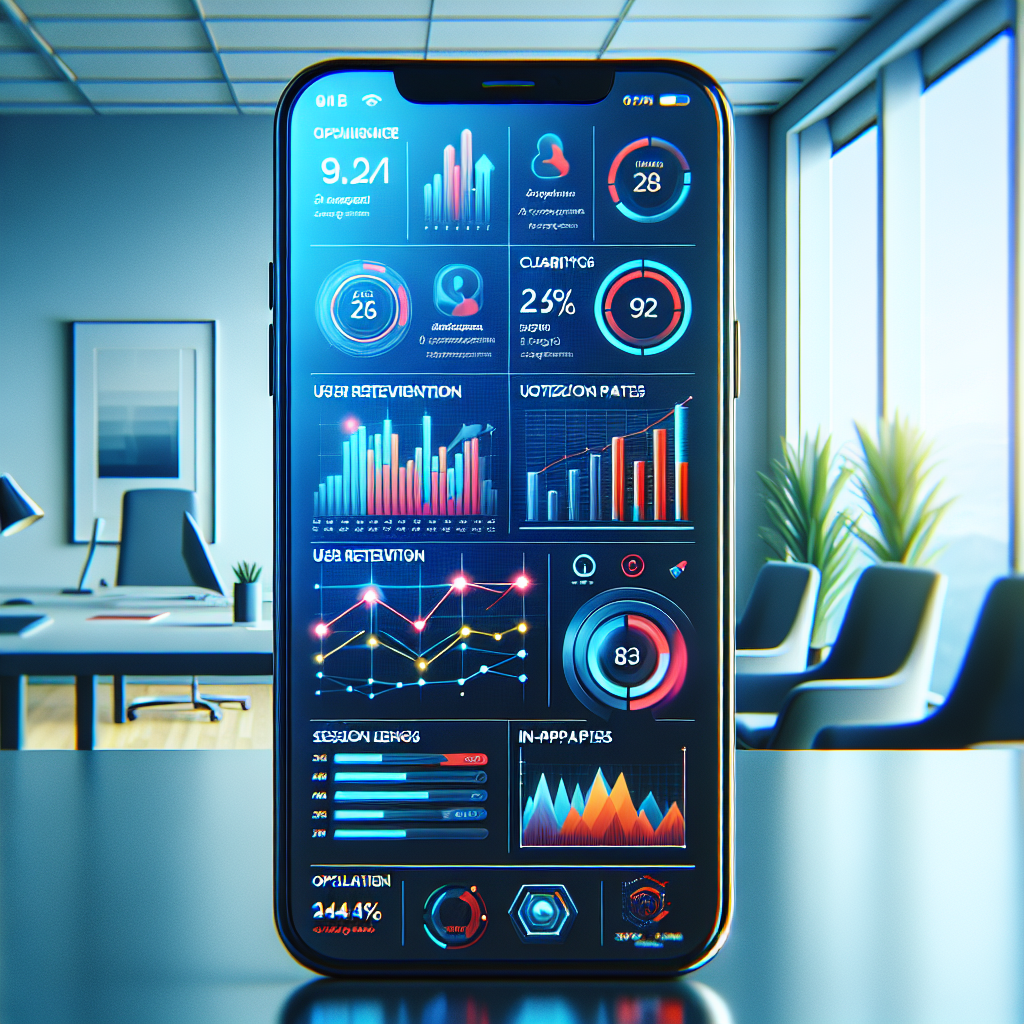In today’s competitive digital landscape, mastering app analytics and optimization is crucial for the success of any mobile application. Understanding how users interact with your app and optimizing its performance can significantly impact user retention, engagement, and overall satisfaction.
App analytics allows you to track key metrics such as user behavior, session lengths, in-app purchases, and more. By analyzing this data, you can make informed decisions to enhance the user experience and address any issues promptly. Optimization, on the other hand, involves refining various aspects of your app based on the insights gathered. This can include improving load times, fixing bugs, and ensuring the app runs smoothly across all devices.
Whether you’re a developer or a business owner, leveraging app analytics and optimization techniques can help you stay ahead of the competition. It’s not just about creating an app; it’s about continuously improving it to meet the evolving needs of your users.
Are you ready to take your app to the next level? Book A Consultation Now! and let us help you navigate the complexities of app analytics and optimization.
Importance of App Analytics for Success
Understanding the importance of app analytics is a game-changer for anyone looking to ensure their app’s success. App analytics provides invaluable insights into user behavior, allowing you to make data-driven decisions that can enhance the user experience and drive growth.
One of the primary benefits of app analytics is its ability to help you identify what is working and what isn’t within your app. For instance, you can track metrics such as user acquisition, retention rates, and engagement levels. This data can reveal patterns and trends that highlight areas needing improvement or features that are particularly popular among users.
Moreover, app analytics can help you understand the effectiveness of your marketing campaigns. By monitoring how users find and interact with your app, you can fine-tune your marketing strategies to target the right audience more effectively. This can lead to higher conversion rates and better return on investment (ROI).
Another critical aspect of app analytics is its role in improving the overall user experience. By analyzing user feedback and behavior, you can identify pain points and optimize the app’s performance. This can include fixing bugs, enhancing features, or simplifying navigation, all of which contribute to higher user satisfaction and loyalty.
In summary, leveraging app analytics is essential for making informed decisions that contribute to your app’s long-term success. It’s a tool that provides a competitive edge by helping you understand your users better and continuously improve your app’s performance.
Key Metrics to Track in App Analytics

Tracking the right metrics is crucial for effective app analytics and optimization. By focusing on key performance indicators (KPIs), you can gain a comprehensive understanding of your app’s performance and user engagement. Here are some essential metrics to monitor:
- Active Users: This metric helps you understand how many users are actively engaging with your app on a daily, weekly, or monthly basis. High numbers indicate strong user retention and engagement.
- User Retention Rate: This measures the percentage of users who return to your app after their first visit. A higher retention rate suggests that users find value in your app, while a low rate may indicate issues that need addressing.
- Session Length: This metric tracks the average amount of time users spend in your app per session. Longer sessions typically mean higher engagement and satisfaction.
- Churn Rate: This measures the percentage of users who stop using your app over a specific period. Understanding why users churn can help you implement strategies to retain them.
- Lifetime Value (LTV): This metric estimates the total revenue you can expect from a user over the entire duration they use your app. It helps in planning long-term marketing and development strategies.
- Cost Per Acquisition (CPA): This measures how much it costs to acquire a new user through marketing campaigns. Lowering CPA while maintaining or increasing user quality is crucial for a sustainable business model.
- In-App Purchases and Revenue: Tracking in-app purchases and overall revenue helps you understand monetization success and identify opportunities for growth.
By focusing on these key metrics, you can make data-driven decisions to optimize your app’s performance, improve user experience, and ultimately drive success.
Effective Techniques for App Optimization

Optimizing your app is essential to ensure it runs smoothly, provides a great user experience, and meets your business goals. Here are some effective techniques for app optimization:
- Performance Optimization: Ensure your app is fast and responsive by minimizing load times and reducing the size of your app. Use code optimization techniques, such as lazy loading and efficient memory management, to improve performance.
- UI/UX Enhancements: A seamless and intuitive user interface (UI) and user experience (UX) are critical for user satisfaction. Regularly update your app’s design based on user feedback and usability testing to improve navigation and accessibility.
- Bug Fixes and Updates: Regularly monitor your app for bugs and promptly address them. Keeping your app up-to-date with the latest features and security patches is essential for maintaining user trust and satisfaction.
- App Store Optimization (ASO): Improve your app’s visibility in app stores by optimizing its title, description, keywords, and visuals. Positive reviews and ratings also play a significant role in ASO.
- Data-Driven Decisions: Use analytics to track user behavior and identify areas for improvement. A/B testing can help you determine which changes have the most positive impact on user engagement and retention.
- Personalization: Tailor your app’s content and features to individual users based on their preferences and behavior. Personalized experiences can significantly enhance user satisfaction and retention.
- Energy Efficiency: Optimize your app to consume less battery power. This can be achieved by minimizing background processes and ensuring efficient use of resources, which can lead to higher user satisfaction.
Implementing these techniques will help you create a high-performing, user-friendly app that stands out in the competitive app market. Regular optimization ensures that your app remains relevant and continues to meet user needs over time.
Tools and Platforms for App Analytics

To master app analytics and optimization, leveraging the right tools and platforms is crucial. These tools help you gather and analyze data, offering valuable insights into user behavior, app performance, and more. Here are some of the most effective tools and platforms for app analytics:
- Google Analytics for Firebase: This powerful tool provides detailed insights into user engagement, retention, and in-app behavior. It integrates seamlessly with other Google services, offering a comprehensive view of your app’s performance.
- Mixpanel: Known for its advanced analytics capabilities, Mixpanel helps you track user actions and understand how users interact with your app. It offers features like funnel analysis, cohort analysis, and A/B testing to optimize user experience.
- Flurry Analytics: A popular choice for mobile app analytics, Flurry offers detailed user insights, session tracking, and event logging. It supports both iOS and Android platforms, making it versatile for different app types.
- App Annie: This platform provides extensive market data and insights, helping you understand your app’s performance relative to competitors. It offers features like download and revenue tracking, user demographics, and app store optimization insights.
- Amplitude: Amplitude focuses on product analytics, helping you understand user journeys and behaviors. Its advanced features include behavioral cohorting, real-time analytics, and user segmentation.
- Localytics: This tool offers comprehensive analytics and marketing automation features. It helps you track user behavior, segment audiences, and run targeted marketing campaigns to improve user engagement and retention.
- Adjust: Adjust provides robust mobile attribution and analytics solutions, helping you measure the effectiveness of your marketing campaigns. It offers features like fraud prevention, audience segmentation, and real-time reporting.
Selecting the right analytics tools and platforms depends on your specific needs and goals. By leveraging these tools, you can gain a deeper understanding of your app’s performance, identify areas for improvement, and drive data-driven decisions to enhance user experience and optimize your app for success.
Case Studies of Successful App Optimization

Understanding the practical application of app analytics and optimization can significantly enhance your approach to improving your app. Here are some compelling case studies that illustrate the impact of effective app optimization:
- Spotify: By leveraging user data, Spotify optimized its app to provide personalized music recommendations. Through continuous A/B testing and user feedback, they improved user engagement and retention, leading to a significant increase in their user base and subscription rates.
- Airbnb: Airbnb utilized advanced analytics to understand user behavior and preferences. By optimizing their onboarding process and enhancing the user interface, they successfully increased bookings and user satisfaction. Their data-driven approach allowed them to identify and prioritize features that mattered most to their users.
- Duolingo: This language learning app used analytics to track user progress and engagement. By identifying drop-off points and optimizing their lesson structure, Duolingo was able to improve user retention and learning outcomes. Their focus on data-driven decision-making allowed them to continually refine their app experience.
- Yelp: Yelp harnessed the power of app analytics to enhance their search and recommendation algorithms. By analyzing user reviews and behavior, they optimized their app to provide more accurate and relevant recommendations, leading to higher user satisfaction and increased app usage.
- Headspace: This meditation app used analytics to understand user engagement patterns and preferences. By optimizing their content delivery and user interface, Headspace increased user retention and subscription rates. Their commitment to data-driven optimization resulted in a more personalized and effective user experience.
These case studies highlight the transformative power of effective app optimization. By integrating advanced analytics and continuously refining your app based on user data, you can achieve remarkable results similar to these industry leaders.
Ready to take your app to the next level? Book A Consultation Now! and let us help you unlock your app’s full potential.
